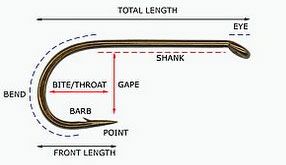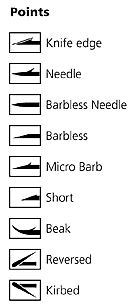

You wander into the tackle shop to buy some hooks, and there in front of you is a huge array of sizes and variations. Confused?
Well this is one market where hooks have mostly been developed to meet the real demands of different methods of fishing, and the type of fish targeted. So this article will try and de-mystify some main choices you may think about in front of the hook displays.

The numbers that define hook sizes can be confusing, but the system is really very simple. Hook sizes are based on a nominal hook size of zero. Hook sizes with a number followed by a zero increase in size as the number goes up.
For instance a 4/0, ("four bar oh" or "four oh"), hook is one size up from a 3/0, which is one size up from a 2/0, etc.
Hook sizes not followed by a zero, decrease in size as the number increases.
For example a size 3 hook is smaller than a size 2 hook, which is smaller than a size 1 hook.
While nearly all hook manufacturers follow this basic numbering system to indicate the increase or decrease in size of each hook within an individual pattern, there is unfortunately little standardisation in overall sizes. For instance what may be a size 4/0 in a Mustad hook may not necessarily be the same as a 4/0 in a Gamakatsu hook.
However hooks for fly tying are much more standardised than saltwater hooks for instance.
For the purposes of this article, all hook-size recommendations are based on the Mustad hook sizes. As an aside, most writers in books and magazines appear to assume the Mustad standard hook sizes when alluding to or recommending hook sizes.
Treble and double hooks follow this sizing convention, that is, a treble or double hook is described by the size of any one of the hooks. For example a size 4/0 treble hook is made up of three 4/0 hooks.
For a good hook size guide, try this chart from Tiemco. It shows fly and salt water hooks.
But you need to remember this - the chart will only show true hook sizes if you print the chart at 100% size.
Your screen pixel size settings will not allow you to see the hooks at their real size.
The chart is in PDF format and it does take a little while to appear - please be patient.
It is my conviction that treble and double hooks should be banned from sale everywhere - they do too much damage to fish, and often to fishermen. If you are into catch and release fishing you cannot in any notion of good conscience use treble or double hooks.
There are other measurements used in identifying hook types and variants - the 'X' factor.
Extra Strength Hooks
Hooks marked '2x strong' or '2x' are made from wire as thick as the next size up. A 3x hook is as thick as a hook two sizes up. These hooks are designed to provide as much strength as a hook one or two sizes up, but where a smaller hook is required.
As an example a 2x 4/0 hook has a wire thickness and strength of a 5/0 hook, and a 3x 4/0 hook has a wire thickness and strength of a 6/0 hook.
Extra strength hooks are often used when live-baiting, to avoid having too much hook visible to the fish.
They are also useful on lures, where using a bigger hook would kill the action of the lure and make it less attractive to fish.
In both these scenarios the extra strength of the smaller hook, equates to a larger size hook.
The other common x standard is the length of the hook
shank.
A '2x long' hook has a shank twice as long as the standard
hook of the same size. A 3x long hook has a shank 3 times as long as
the standard sized hook. 'X' long are hooks mostly found in
fly-tying hooks.
Unfortunately this standard is anything but.
However most hook manufacturers do use the 'standard', but some the one size up convention. That is a 2x long hook has a shaft the same length as the next size up hook. For example a size 10 2x long hook will have a shaft length of a size 8 hook. (Remember sizes without the /0 increase in size as the number decreases)
The only way to overcome this confusion to check the manufacturers sizing charts.
A less common, but important variant are 'wide gape'
hooks.
A wide gape hook is one where the gape, (the gap between the hook
point and hook shaft) is wider than the standard hook. Sometimes the
wide gape hook is described as '2x wide', and the hook should
have a gape twice as wide as the standard hook, or in some cases the
same size gape as the next hook size up - but there is little
standardisation in this area, even amongst hooks from the same
manufacturer. Again reference to a size chart is the only way to be
sure of what you are buying.

Hooks come in around nine point variants and all are designed to achieve different objectives.
A knife edge point is designed to cut into flesh and
bone, and is useful for most 'hard' mouthed fish. But they do have the
disadvantage of cutting in and out.
A needle point hook is pretty much what it looks
like, a needle. Needle points have good penetration, but not as good
as knife edge hooks. However, needle points do not cut once in the
fishes mouth and are less likely to cut their way out.
Barbless hooks are just that, and can be in any point
variant.
'Micro' barbs are very small barbs
that are mainly seen on small hooks for trout and coarse fishing.
A 'short' barb hook is a barb nearer the hook
point than on a standard hook.
A 'beak' hook is where the point of the hook curves
up towards the shank, in front of the barb.
Kirbed or Reversed hook points are points that curve
away at an angle to the shank. They are said to provide a better
hook-up rate as the point does not get deflected by the shank. Most
people call all hooks like this 'kirbed 'hooks, but strictly speaking
a kirbed hook point bends out to the right looking straight-on to the
shaft, and the reversed hook point bends out to the left.
Standard hooks are made from wire that is bent into shape, then the point sharpened and barb added. The wire retains its round shape throughout the hook.
Forged hooks, once the shape has been made, have the sides of the shank and bend flattened which makes them much stronger than standard hooks - but a good deal more expensive.
They are commonly used in big game fishing where hook strength is vital, but many trophy hunters and competition fishers use them in salt and fresh water fishing.
How Big A Hook Is Enough?
First a quick lurch into trout fishing. Dyed in the wool saltwater fishermen are often amazed at the large size of trout that can be caught on seemingly tiny hooks. Trout of 2 or 3kg (4 - 6lb) and over are routinely caught on barely-visible size 18 hooks and smaller.
The same can be true in saltwater as those who use small 'keeper' hooks will attest. Regularly, snapper are caught on the 1/0 or 2/0 keeper hooks. It is not a huge mind jump to think of the size of a 12/0 big game hook, hanging out of the jaw of a marlin. Size is relative.
As a general rule I judge the hook size I need to use as a function of the bait size I am using, not the size of the fish I am targeting. The fish I am targeting determines the bait size.
If I am using a whole skipjack tuna head when chasing big snapper I will use a 10/0 to 12/0 hook, but when using pilchards, a 4/0 or 5/0 is the norm.
It is an enlightening demonstration to tie some line to a hook, place the hook point in a piece of wood, and haul on the line. The amount of force required to bend the hook out is usually much more than you would normally pull through a rod with a correct drag setting.
If a hook straightens during a fight it is not usually a function of the hook size, but a function of the quality of the hook
Stainless or Not?
The prime reason that seems to govern the purchase of stainless hooks is storage. Stainless hooks will not rust as fast as non-stainless hooks in the tackle box. But stainless hooks have some disadvantages:
There is a rule that must be observed when storing unused hooks, stainless or otherwise.
I try to keep new, unused hooks in their packets and only take out what I think I need for the trip. Even fumbling about in a packet of hooks with wet hands, especially seawater, can set off rust and corrosion.
Quick hook storage tip: Save those little packets of desicant drying powder that come with pills and many electrical products. They are great to put in hook containers, tackle and lure boxes.
Sharpen Hooks?
Books and articles still being written contain encouragement to sharpen hooks before fishing with them. 'No hook is sharp enough to fish straight out of the packet' is and was the advice.
In most cases trying to sharpen chemically or laser sharpened hooks out of the packet will actually blunt them.
Chemically sharpened and laser sharpened hooks are made in much the same way.
Once the hook is formed, the points are treated with a chemical and then introduced to a laser beam, or other control source, which wears away the metal leaving a very sharp point.
However hooks may need sharpening after use. Fly fishermen especially should regularly check their flies - hooks bouncing onto stones and rocks can get blunt, and may need sharpening.
If you do sharpen hooks there are a number of factors to bear in mind.
All sharpening produces heat. Too much heat will reduce the temper of the hook that can soften the point. This can lead to points bending over, or breaking off. It is important when sharpening hooks to use a slow stroke with the file or stone.
Be careful not to remove too much metal from the point. There is a fine line between a sharp point and a weak point.
It is too easy to think of a hook point as always being pulled into a fish in a straight-line pull. However, this is not always true. Many times the pull is at an angle to the point. If there is not enough metal in the point it can break off or bend over.
Barbs?
Here is a little piece of surprise from the history books. It seems that barbs were initially introduced, not to hold the fish on once hooked, but to stop the bait coming off.
I often fish with barbless hooks.
I guess what launched me into barbless hooks was acting as a deckhand on a commercial tuna boat off the Three Kings Islands off the northern tip of NZ many years ago. On these trips we would tow hand lines pulling tuna lures. We were fishing for the Japanese market, so the object was to land the fish in as top condition as possible, for airfreighting to the markets in Tokyo.
The system was simple.
The hand lines were secured to the rails of the boat by string of a known breaking strain, and then to a Dan buoy. If the fish was big enough, the string broke and pulled the hand line, attached to the buoy, overboard. We simply did a turn and went back to pick up the fish. On good days we would pick up ten or more Yellowfin tuna.
Here is the important news, the hooks were all barbless.
Here is even more important news, even when the tuna had been under a buoy, and there had been slack in the system, I did not see one tuna come off the hook.
There is an important aspect about this that cannot be ignored. The breakaway system we were using ensured that hooks were always well and deeply set.
This, I think is a key point, barbless hooks are easier to set.
Fast, Easy & Safe Release
The prime advantage of barbless hooks is that they are easy to remove. If you regularly catch and release fish, you should use barbless hooks.
You can make hooks barbless by filing off the barb, but I have found that sometimes the heat generated by filing does reduce the hook's temper and weakens the hook.
I prefer to use a pair of parallel-jawed pliers to crush down the barb. This does the job without damaging the hook.
There is another advantage to barbless hooks, and it is one that the commercial boys have homed in on. In a hot bite, it is easier to remove the hook, easier to remove residual bait, therefore you can get another bait back into the water much more quickly.
And the first time you sink a barbed hook into a part of your body, and have to go through the drama of having it removed, you will become a barbless devotee.
![]() More Info
More Info
Visit Mustad's site for a run down on all their hooks types, shapes, sizes etc. But remember the sizes of hooks shown on screen are NOT true to size - your computer screen resolution does not allow for true real-life size representation. But the size charts will provide a good guide to size differences within a hook type.
![]() Next Step: How to set the hook
Next Step: How to set the hook
For information on setting the hook to get a firm hook up see this article.

Article written by Tony Bishop (Bish)
Milly & Ted's Big Day Out Fishing

They'd ‘had words’. Their faces and body language told the story, even to a casual observer.
Onlookers, and there were a good few of us, studied clouds to see if we could find faces in them, or did a detailed inspection of our shoe laces to make sure they remained tied, trying to stifle laughter.
How to tie fishing knots properly & securely

It is my guess that more fish are lost to poorly tied knots, than from any other single factor.
There are many knots available to fishers, but no matter which knot you choose there is one factor that remains true. If you do not practice tying the chosen knot so that you can tie it easily and securely, you will lose fish to knots coming undone...
Catch more fish by ‘fishing your feet first’

"Fush yer feet firrst", he grunted.
"I beg your pardon?’ I said, in the deference to age that was
still quite common in those days.
‘Fish your feet first", he slowly and more clearly enunciated,
‘you have just put down some good fish’.
I did not have a clue what he was on about, but all was soon
revealed.
If you want fresh fish from catching to the table - chill out!

Keeping fish in top condition from the time you catch it till the time it is cooked is relatively easy, and oh, what a difference it makes to the taste.
It is a sad fact is that much of the fish served up by amateur fishermen is passed its used-by-date. By the time it reaches the table it is well on the way to being rotten. What a waste. But it does not have to be that way...
